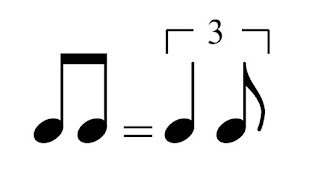Triplet Feel
Blues music often has a distinctive feel to the rhythm. Listen to the famous piece 'Dust my Broom' by Elmore James and you can hear the bouncy, offset rhythm played by Elmore permeating the whole song. This rhythmic style predominates in most blues music and is also used in many other musical styles. So what causes the music to sound this way and how do you play it?
Getting the feel for the triplets
In musical notation you will usually see this symbol at the start of a piece of blues music:
 |
| Image from musescore.org |
This symbol or direction is referred to as Triplet Feel and alters the timing of how the 1/8 notes (quavers) are played throughout the music. In concise terms what this does is that for 8th notes instead of playing them at the regular 8th duration in the equispaced intervals commonly used, they now are played as if they part of a triplet, either for the duration of 2/3 of the triplet or for 1/3 of the triplet depending on where they appear in the score. In terms of duration, that means that every 8th note will now have a duration of either 1/6 or 1/12. I is also worth noting that this is applied consistently across every bar it affects i.e. every time an 8th note falls on the beat, it is played as a 1/6, and every time it falls between the beat by 1/8th, it is played as a 1/12.
It is also worth noting that a triplet feel, when shown with the above symbol only affects 1/8th notes in the music. Other notes are played at their standard durations. Triplet feel can be applied to other notes as well but in this post we will only look at the above application as it is the most common used in blues music.
Simplifying Things
The explanation above probably sounds a bit overbearing and difficult to put into practise so I will try and simplify it by way of a small exercise. For the exercise it is assumed 4/4 time which is four 1/4 notes (crotchets) in every bar which is the most common in blues music.
- Set a metronome at your desired speed, 80bpm would be fine
- Play a note on every beat of the metronome - these are 1/4 notes (crotchets)
- Now play 2 notes with equal duration and spacing on every beat - these are 1/8 notes (quavers) without a triplet feel applied
- Next play 3 notes with equal duration and spacing on every beat - these are 1/8 note triplets
- Now play the triplets from the previous step again but this time don't play the second note of the triplet i.e. let the first note of the triplet sound for the duration of the first two notes in the triplet. (it is perhaps easier if you count 1,2,3 in your head for every note of the triplet to help keep time.)
- And that's it. If your timing is accurate you should now you be playing those 1/8 notes with a triplet feel and you should hear that distinctive rhythmic style.
Listen to the Rhythm
For musical exercises such as this it is often easier just to hear how it sounds and try to learn from that. So i have put together a powertab file showing this. I have split it into 5 different exercises for you to practise so you can get the hang of playing this way. Each exercise shows how this triplet feel sounds depending on where the notes are played in the bar.
Below are links to the powertab file, a pdf copy of this and brief explanations of the exercises:
Triplet Feel Demonstration and Exercises - Power Tab
Triplet Feel Exercises - pdf
Exercise 1: 1/8 notes with a triplet feel are played continuously for 2 bars starting on the first beat of the bar.
 |
| Captured From Power Tab |
Exercise 2: Two 1/8 notes with a triplet feel are played then a 1/4 rest before repeating. Each grouping of two starts on the beat of the bar.
 |
| Captured From Power Tab |
Exercise 3: Two 1/8 notes with a triplet feel are played then a 1/4 rest before repeating. Each grouping of two starts off the beat of the bar by 1/8. This shows how the note duration is dependent on where it falls in the bar, not where it falls in the grouping of the notes played.
 |
| Captured From Power Tab |
Exercise 4: Two 1/8 notes with a triplet feel are played then an 1/8 rest before repeating. This alternates between each group of notes starting on the the beat of the bar or off the beat by 1/8th.
 |
| Captured From Power Tab |
Exercise 5: Two 1/8 notes with a triplet feel are played then an 1/8 rest before repeating. This time the sequence starts off the beat of the bar by 1/8 and there is a 1/4 rest between bars 2 and 3.
 |
| Captured From Power Tab |
Finishing Up
Hopefully now you are starting to get an understanding of how what this triplet feel is and how it is applied in the music. This small alteration in the timing really makes a huge difference to the overall sound and is really fundamental when playing blues music. With some practise you will soon get the hang of it and you will be playing out the rhythm like a blues master.
Thanks for reading,
Neil
Comments
Post a Comment